What Are the Best Goat Breeds for Milk?
Many of us have grown up drinking cow’s milk, so it may surprise you that approximately 70% of the dairy consumed globally comes from goats. Goat milk is the number one source of dairy in many countries and is gaining popularity in countries that traditionally drink cow’s milk. If you have decided to raise dairy goats, you can set yourself up for success by purchasing the right breed.
Which goat breeds are best for milk production? Of course, all goat breeds produce milk, but the goats explicitly bred for dairy production will yield the highest quantity of butterfat-rich milk. Seven of the best goat breeds for milk are:
- Saanen Goat
- French Alpine Goat
- LaMancha Goat
- Nigerian Dwarf Goat
- Nubian Goat
- Toggenburg Goat
- Oberhasli Goat
You have to raise a proven dairy-producing breed if you want goat’s milk. While each of the breeds in this list are successful dairy breeds, they all have their strengths and weaknesses, and which breed you choose will depend on your specific operation. Read on to learn more about what each of these goat breeds offers.
#1 Milk Goat Breed: Saanen

The Saanen produces more milk than any other goat breed – up to 3 gallons per day. Saanens are often called the “Holsteins” of the goat world. Their milk contains approximately 3-4% butterfat, which is average among goat milk breeds. Saanens are a large breed, reaching around 150 pounds at maturity. They are all-white in color and are susceptible to sunburn (and skin cancer) if adequate shade is not provided.
Saanens are hardy but do best under more intensive management due to their additional dietary requirements. Because they produce such an abundance of milk, their diets must be closely managed to ensure adequate caloric and protein intake. If your goal is to have enough milk for your family, the Saanen might be too much goat for you.
#2 Milk Goat Breed: French Alpine
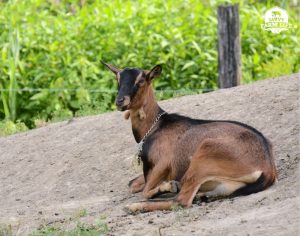
French Alpines come in second place in terms of high yield of milk. They consistently produce up to 2 gallons of milk per day, with a butterfat percentage of 3.3%. They are similar in size to the Saanen, reaching a mature weight of around 150 pounds, and have large, well-shaped udders – making them easier on the hands when manually milking.
As with the Saanen, the French Alpine is best suited to commercial operations instead of small self-sustainable homesteads due to their high production rate and the necessary dietary supplementation. French Alpines also do best on pasture – they are strong-willed and grow unruly when in small confinement. Lastly – French Alpines are susceptible to internal parasites, which presents a challenge when keeping them in humid climates.
#3 Milk Goat Breed: LaMancha
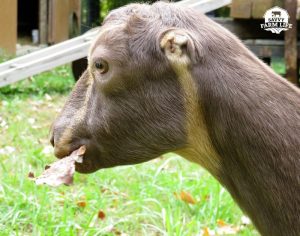
LaManchas produce approximately ¾ of a gallon of milk per day. Their milk is higher in butterfat compared to that of other large dairy breeds – roughly 4.2% and is unique in that they can go longer than other breeds (up to 2 years) without being “refreshed” (impregnated). LaManchas mature to 120-130 pounds and have distinctive small-to-non-existent ears.
LaManchas are used in commercial dairy operations and are highly suitable for smaller homesteads. While they produce an adequate quantity of milk, the yield is not overwhelming for a smaller operation. In addition to their dairy production, they also excel at clearing brush. Finally, they are also sweet-natured and gentle, making them a pleasure for any member of the family to handle.
#4 Milk Goat Breed: Nigerian Dwarf
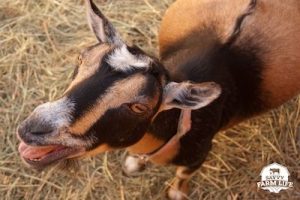
Nigerian Dwarf goats are the smallest of goat breeds, maturing at only 50-70 pounds, and those bred for their milk can produce as much as ½ gallon of milk per day. They have an exceptionally high percentage of butterfat in their milk – approximately 6-10%.
Nigerian Dwarfs are not the best choice for commercial production but are well-suited for a homestead looking for a sustainable dairy source and as a pet. Nigerian Dwarfs make excellent pets because of their manageable size and gentle, friendly dispositions. Though a lovely homestead breed, they are known to be escape artists, so you must have adequate fencing to keep them safe.
If you decide to purchase a Nigerian Dwarf, discuss the parentage and traits with the breeder. Many Nigerian Dwarf goats are bred strictly as pets and will be less productive than dairy goats. You will want a Nigerian Dwarf bred to be a dairy goat.
#5 Milk Goat Breed: Nubian
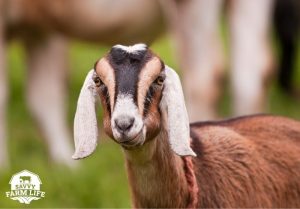
Nubians produce up to 1 gallon of milk per day, with a butterfat content of 5% (highest among the large dairy breeds). They weigh between 140 and 175 pounds at maturity and are a popular dual-purpose goat breed often used for meat production.
Nubians do best in warm-hot climates and are known as an especially loud breed. If you live on a more modest property with close neighbors, you might do well to select a quieter breed (like the Oberhasli or the Nigerian Dwarf). They are an excellent breed for homesteads looking to gain both milk and meat from their goats.
Did you know that Nubian goats are often bred to smaller goat breeds to give birth to a smaller more manageable goat that is still able to produce a good amount of milk and meat? To learn more, visit my article 8 Adorable Small Goat Breeds (With Pictures).
#6 Milk Goat Breed: Toggenburg
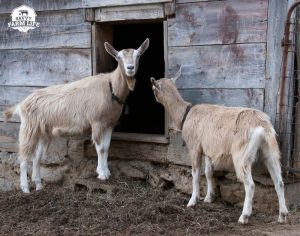
Toggenburgs are considered to be the oldest breed of dairy goat. They can produce up to 1 ½ – 2 gallons of milk per day, with their milk having only 2-3% butterfat, making it less suitable for some dairy products such as butter and cheese. Toggenburgs are frequently used in crossbreeding programs.
Toggenburgs are medium-large in size, maturing to 120-145 pounds when fully grown. They are known to be exceptionally sturdy and courageous – with stories abounding of Toggenburg bucks tackling and taking down predators. They are, however, not the best choice for inexperienced or younger handlers – Toggenburgs are known to be on the cranky side and are famous for challenging both humans and other animals.
#7 Milk Goat Breed: Oberhasli
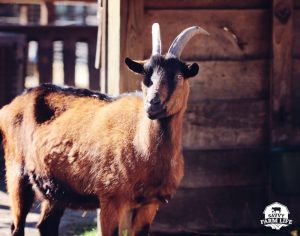
The Oberhasli is another old dairy goat breed that originated in Switzerland. Oberhaslis can produce ½ – 1 gallon of milk per day with approximately 3.8% butterfat. Some say that the Oberhasli’s dairy production is not as consistent as other breeds, though the breed has a high feed efficiency rate.
Oberhaslis are confident goats – friendly and steady and not easily spooked. They are gentle with their human handlers but tend to be the dominant goats in a mixed-breed herd. While Oberhaslis do best in colder regions, they adapt well to various climates.
What You Want In A Milk Goat
Several factors come into play when considering what makes a good dairy goat, but three of the most important are quantity of milk, butterfat percentage, and temperament. Does this mean you should select a breed that produces the most significant amount of milk or the mildest disposition? Not necessarily – each operation or homestead will have different needs in these departments.
How much milk does the goat produce?
The most obvious trait of a thriving dairy goat will be the quantity of milk produced. There is a significant range in yield among the breeds in this list – with some producing as little as ½ a gallon per day and others producing as much as 3 gallons per day. However, the goat that produces the most milk is not necessarily the best goat for your operation. If you are merely looking for a goat for your homestead that will provide dairy for your family, a goat that produces 3 gallons per day may soon overwhelm you with milk. Start your search by determining the needs of your operation.
What is the butterfat percentage in goat’s milk?
The amount of butterfat in the goat’s milk will affect its taste – a higher percentage of butterfat will lead to a sweeter, less “goaty” tasting milk. A higher percentage of butterfat will also allow you to make more butter or other cream-based products from the milk. If your goal in raising dairy goats is to make and sell butter, you may want to go with a breed with a lower overall yield but a more significant butterfat percentage.
What is the goat’s temperament?
The goat’s temperament must match the needs of your operation. If you are looking for a couple of homestead goats and would like your young children to be involved in the handling and milking, you will want a gentler, more docile goat. If you are in an area with significant wildlife and predators, you may want a tougher, more aggressive breed that will not easily spook if they spot a coyote on the other side of the fence. While every individual goat will have its own unique personality, each breed will have a standard disposition.
Goat Milk: An Increasingly Popular Cow’s Milk Alternative
Goat milk is the dominant source of dairy in many countries, including India, Turkey, and most of Eastern Europe, South America, and the Middle East. As for the rest of the world – the demand for goat milk is expected to grow over the next decade. Whether you are looking to create a profitable dairy goat business or in the market for a sustainable milk source for your own family, you can’t go wrong with the above-proven dairy breeds.
Are you looking to raise goats for meat? If so, take a look at my article Meat Goat Breeds: 8 Best Goat Breeds For Tasty Meat.
